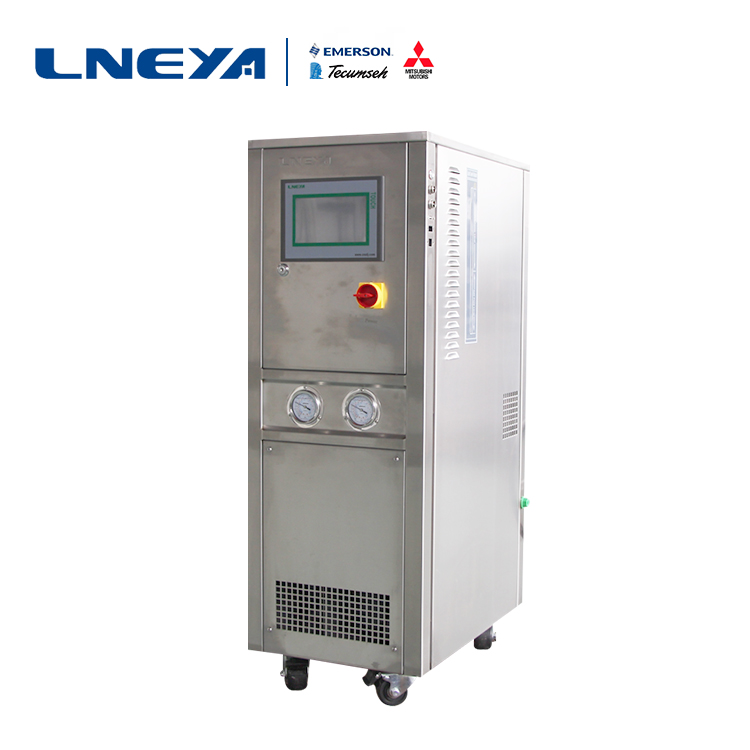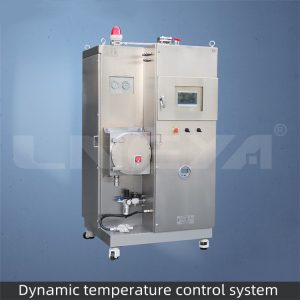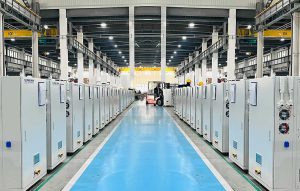반도체 웨이퍼 온도 제어의 냉동 원리 설명
In the operation of the semiconductor wafer temperature control refrigeration system, a state transition of a certain working fluid is used, and the necessary heat Q0 is extracted from the heat source of a lower temperature, and the heat Qk is sent to the heat source of the tropical heat through a storage process of the consumption power W. In this process, Qk = Q0 + W is taken from the conservation of energy.
In order to achieve temperature control of semiconductor wafer temperature migration, a process of lowering the temperature of the refrigerant to a lower temperature environment is forcibly performed, and heat is continuously extracted from the object to be cooled, and this is achieved within the boundary of the refrigeration technique. The process has several basic steps: phase change refrigeration: the use of liquid evaporation at low temperatures or the dissolution or sublimation of solids at low temperatures to extract heat from the object being cooled. Normal air conditioners are all such cooling steps. Gas expansion refrigeration: The high pressure gas can reach a lower temperature after adiabatic expansion, so that the low pressure gas can be reheated to cool. Gas eddy current refrigeration: After the high pressure gas is expanded by the vortex tube, it can be respectively hot and cold air flow, and can be cooled by the reheating process of the cool air flow. Thermoelectric cooling: The direct current is passed through the semiconductor thermopile, which can have a cold effect at one end and a thermal effect at the other end.

The temperature of the semiconductor wafer is controlled during operation. At the high temperature, no heat transfer medium evaporates, and it can be realized without pressure. -80 to 190 degrees, -70 to 220 degrees, -88 to 170 degrees, -55 to 250. Degree, -30 ~ 300 degrees continuous temperature control. The principle and function of semiconductor wafer temperature control have many advantages for the user: Because only the heat transfer medium in the expansion chamber is in contact with the oxygen in the air (and the temperature of the expansion tank is between normal temperature and 60 degrees), the reduction can be achieved. The heat transfer medium is oxidized and absorbs moisture in the air.
In the semiconductor wafer temperature control, the principle of refrigeration is as shown above. When the user controls the temperature control of the semiconductor wafer, the user should pay attention to the principle of refrigeration, and better operate the semiconductor wafer temperature control after understanding.
관련 권장 사항
-
Application of crystallization technology of ultra-low temperature chiller in petroleum industry
954This article mainly introduces the application of the freezing technology crystallization technology of industrial refrigerators in the oil industry and the principle of freezing crystallization. At present, the separation method using freeze crys...
세부 정보 보기 -
Operating instructions for the chiller, a laboratory process temperature control cycle system
1119The heat transfer medium of the laboratory process temperature control circulation system chiller uses oil and water. It uses electric heating to heat the heat transfer medium (heat transfer oil or water) that is forced to circulate in the pipelin...
세부 정보 보기 -
전기 회사에 냉각 시스템 산업용 냉각기가 필요한 이유는 무엇입니까?
977전기 장비가 실외에서 작동하는 경우 고온 환경에 노출될 수 있습니다. 예를 들어 여름철 직사광선이 내리쬐는 곳에서는 온도가 매우 높을 수 있습니다. 장비가 과열되면 성능에 영향을 미치거나 심지어 ...
세부 정보 보기 -
반도체 제조 기업에 가열 서큘레이터 장비가 필요한 이유는 무엇일까요?
1129온도 제어 정확도: 반도체 제조 공정은 온도 제어에 대한 요구 사항이 매우 엄격합니다. 가열 순환기는 정밀한 온도 제어를 제공하여 온도가 일정하게 유지되도록 보장할 수 있습니다.
세부 정보 보기
 LNEYA 산업용 냉각기 제조업체 공급 업체
LNEYA 산업용 냉각기 제조업체 공급 업체












